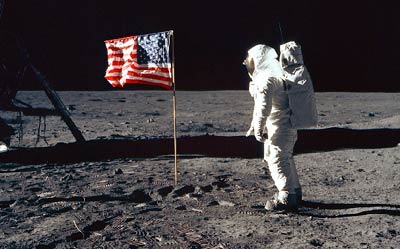Apollo and America’s Cold War (part 1)by Taylor Dinerman
|
| Sputnik was the USSR’s greatest propaganda victory. |
At the time memories of the Korean War were fresh in everyone’s minds. The Democrats were smarting from GOP accusations of having been “soft” on communism. Eisenhower was worried about the after effects of the 1950–1953 military build-up. His priority was to try and balance his desire to restrain the growth of government spending, with the need to maintain enough strength to contain Soviet Russia and Mao’s China. He needed to know what the real military and economic strength of those powers was.
When he moved into the White House Ike had been appalled to find just how little hard intelligence the US had on the situation in Russia and China. At best the CIA could only give him a few educated guesses, and he distrusted military intelligence estimates due to his knowledge of the way budget politics were played and his experience of intelligence failures from Pearl Harbor and the Battle of the Bulge to the Berlin Blockade and the outbreak of the Korean War.
To remedy this he ordered the CIA and the Air Force to begin work on both the U-2 spy plane and on the WS-117L program, which evolved into the CORONA spy satellite program. From the president’s point of view this was a logical, restrained program that answered a specific national need. He never imagined that space would emerge dramatically as a public political issue.
All of Ike’s careful plans were destroyed when the Soviets launched Sputnik. The Democrats jumped on this unexpected political gift and used it to savage the President’s policy of budgetary restraint. The USSR and Khrushchev were dumbfounded at the US response. America suddenly was presenting itself to the rest of the world as being technologically backward? The propaganda advantage was huge.
Eisenhower tried to calm down the American people, but his effort, in spite of being based on the self-evident fact that the US held an overwhelming advantage in every militarily significant technology with the exception of large rocket engines, failed. It was too good a theme for the Democrats to abandon and for the media it was a perfect story.
The image of old Ike wasting time on the golf course while the Soviets were busy building rockets was burned into the people’s consciousness. The “Missile Gap” became the centerpiece of the 1960 campaign. JFK said, “We are facing a gap on which we are gambling our survival.”
Kennedy promised vigor, he was going to get the country moving again after eight years of Republican lethargy in the White House. He also promised to do a better job fighting the Cold War than his predecessors. When it came to the space program he and his advisors were seriously conflicted. His science advisor, Jerome Wiesner, disliked human spaceflight. Like many scientists he thought of it as a waste of time. JFK’s vice president, Lyndon Johnson, was an avid supporter: he saw it not just in terms of enhancing America’s global prestige, but also as a continuation of Franklin Roosevelt’s New Deal infrastructure development programs.
The troubles and humiliations of Kennedy’s first months in office pushed him to come down on Johnson’s side of the argument. Nothing, he noted, would be as difficult or as impressive to the rest of mankind as “landing a man on the Moon and returning him safely to the Earth.” He was confident that the US could beat the Soviets to the Moon since his intelligence, provided by the CORONA satellites that were the offspring of Ike’s WS-117L program, showed that in reality their rocket program was both limited and relatively primitive.
| Once the Apollo program gained momentum it also gained widespread and bipartisan political support. America was committed to beating the Soviet Union to the Moon. |
When JFK’s defense secretary told the press that the Missile Gap was a delusion, this utterly humiliated Khrushchev and the Politburo. As a response they decided to ship almost all their medium and intermediate range nuclear missiles to Cuba, thus setting the stage for the Cuban Missile Crisis of October 1962. They also pushed for ever more spectacular space firsts. The first two-man crew, the first woman, the first Moon shot, and whatever else they could get Sergei Korolev to fit on top of his R-7 they launched. By the mid-1960s the propaganda effect wore thin.
Once the Apollo program gained momentum it also gained widespread and bipartisan political support. America was committed to beating the Soviet Union to the Moon. NASA put together what seemed at the time like a reasonable step-by-step approach that moved from Mercury to Gemini to Apollo. In fact there was considerable controversy within the agency over the best approach and, to this day, there are those who wish that the US had built a space station first and used it as a base for the lunar mission.
At the time of his assassination in November 1963 the Apollo Moon program was well-established as one of the administration’s major achievements. JFK and LBJ were going to show the Republicans, and the rest of the world, that they could beat the Russians to the Moon. The shape of the US space industry with its overlapping commercial, scientific, military, and manned exploration sections was put in place and has not substantially changed over the last 46 years.
